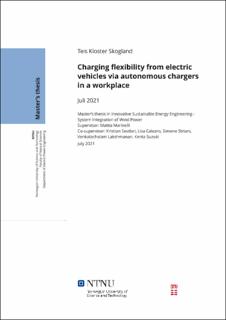| dc.description.abstract | As a part of the ongoing project Autonomously Controlled Distributed Chargers (ACDC), This thesis have designed an autonomous charging controller, with a distributed control architecture incorporating virtual aggregator capabilities.
In order to limit global warming, as stated by the Paris agreement 2015, decarbonising of the energy sector is key. Large scale electrification, and reduction of fossil fuel bases energy production is needed. To enable high penetration of uncontrollable renewable energy sources, demand side flexibility is needed. Sector coupling is also suggested as a solution. This could be done by integrating the transportation sector into the power sector. The idea is to use the storage capacity from Electric vehicles (EV) to benefit the electrical power system.
Electrification of the transportation sector is also necessary. To enable high penetration levels of EVs, it is important to integrate them to the grid in such a way that they could be of benefit to the system, instead of increasing peak loads and becoming a burden. The way of doing this is by use of smart charging.
This thesis have been focused on designing an autonomous charging controller, by use of a distributed control architecture. The model is capable of coordinating the charging of 18 EVs connected via nine chargers, with two outlets each, which is typically found in a workplace parking lot. The model uses historical EV data from 18 Nissan LEAFs. The idea is that by use of a distributed control architecture will enable high penetration of EVs in a cost effective and simple manner. The controller could operate independently, but also contribute with flexibility by responding to demand-response signals, such as power limitation, and load balancing. A virtual aggregator is incorporated in every charger which distributes a dynamic power signal. This signal can be changed to provide flexibility to the grid operator, or to provide behind-the-meter services.
The model have been developed in MATLAB Simulink. The model utilises historical EV data consisting of arrival time, departure time and State of Charge (SOC). The model autonomously coordinates charging of the 18 EVs, while keeping the power within desired limits.
To analyse the results, a total of 3 different cases with smart charging have been analysed, in addition to a base case utilising uncontrolled, dumb charging. By distributing the demand throughout the day, and with times of surplus power, the smart charger reduces peak loads. The result show that smart charging can reduce the required charging power by a factor of three, compared to dumb charging, and still deliver satisfying results when considering the total charged energy, and the SOC for every EV. From an economic perspective, taking this power difference into consideration could make the total investment of smart chargers cheaper compared to dumb chargers. | |
